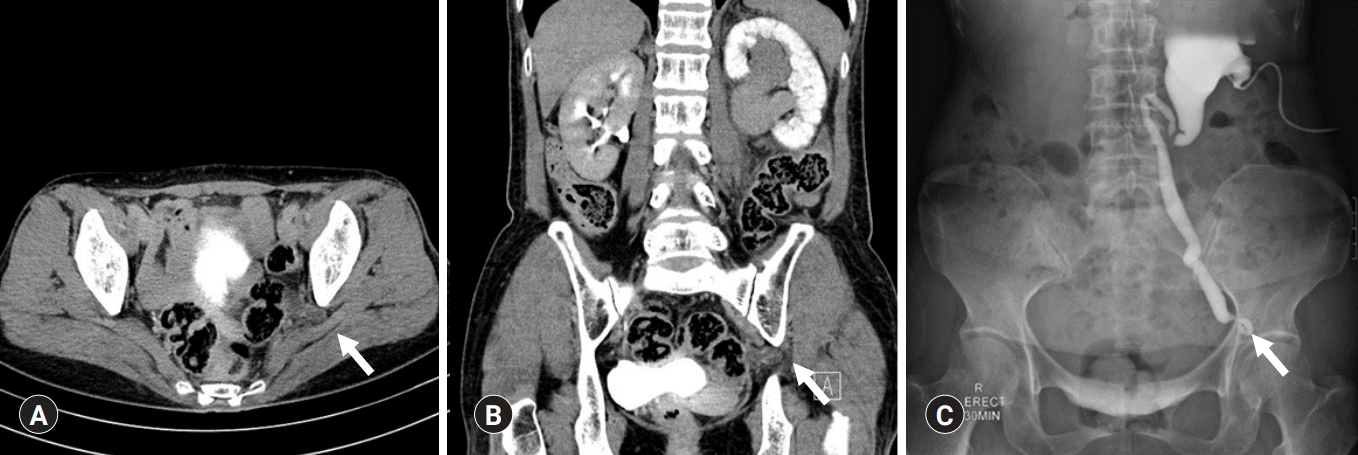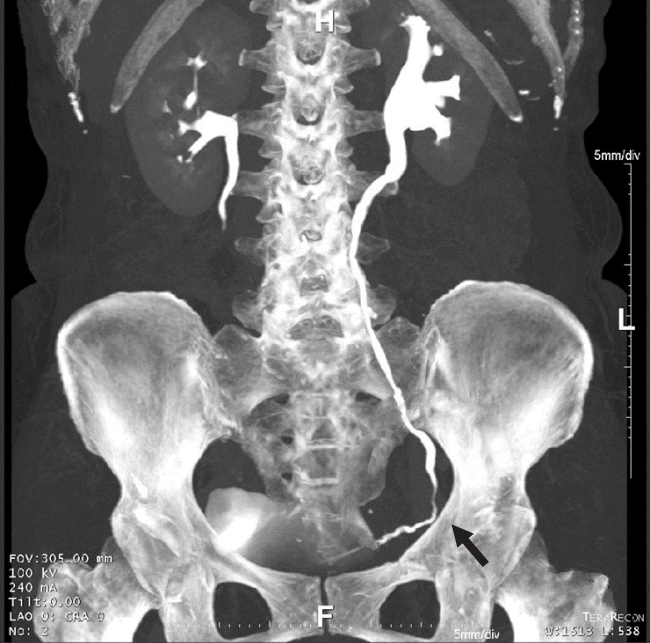This article has been
cited by other articles in ScienceCentral.
Abstract
Ureterosciatic hernia is extremely rare. In ureteral herniation, ureter prolapses occur through either the greater or lesser sciatic foramen. Atrophy of the piriformis muscle, hip joint diseases, and defects in the parietal pelvic fascia are predisposing factors for the development of ureterosciatic hernia. Most symptomatic patients have been treated surgically, with conservative treatment reserved only for asymptomatic patients. To the best of our knowledge, long-term follow-up outcomes after ureterosciatic hernia management are sparse. In this paper, we report the case of a 68-year-old woman who presented with colicky left abdominal pain. After computed tomography (CT) scan and anterograde pyelography, she was diagnosed ureterosciatic hernia with obstructive uropathy. We performed ureteral balloon dilatation and double-J ureteral stent placement. After this minimally invasive procedure, CT scan demonstrated that the left ureter had returned to its normal anatomical position without looping into the sciatic foramen. The patient remained asymptomatic with no adverse events 7 years after the minimally invasive procedures. This brief report describes ureterosciatic hernia successfully managed with minimally invasive procedures with long-term follow-up outcomes.
Go to :

Keywords: Hernia, Minimally invasive surgical procedures, Treatment outcome, Ureter
Introduction
Obstructive uropathy can be caused by fibrotic ureteral stricture, ureteral calculi, ureteral malignancy, and several types of external compression. Ureteral hernia is rare, hence its very limited literature worldwide, but potentially serious because it may lead to ureteral obstruction. Of the many types of ureteral hernias, ureterosciatic hernia is extremely rare, with only 30 reported cases of ureterosciatic hernia as of 2018 [
1,
2]. Most symptomatic patients undergo surgical procedures, while those who are asymptomatic receive conservative treatment. To the best of our knowledge, long-term follow-up outcomes after ureterosciatic hernia management are sparse. This brief report describes ureterosciatic hernia successfully managed with minimal invasive procedures with long-term follow-up outcomes.
Go to :

Case
This report was approved by the Institutional Review Board (IRB) of the Yeungnam University Hospital (IRB No: 2020-06-047). Written informed consent was obtained from the patient for publication of this case report and accompanying images.
In 2013, a 68-year-old Korean woman sought consult at our hospital because of colicky left abdominal pain for several days. The patient was generally in good health, with stable vital signs and a normal body mass index. Laboratory examinations revealed mild leukocytosis. On physical examination, she complained of left costovertebral angle tenderness. Her past medical history included a gynecological operation for a left ovarian abscess in 2009. After physical examination we carried out radiological evaluation; simple X-ray images did not reveal any abnormal lesion. We then decided to use more detailed radiological imaging modalities. Computed tomography (CT) scan, normally used for evaluating of urinary tract stone or obstructive uropathy, identified that the left ureter was grossly dilated, and that the loop of the ureter was displaced through the sciatic notch (
Fig. 1A,
1B). No evidence of calculi or masses was seen in kidney and ureter. To resolve left hydronephrosis, left percutaneous nephrostomy (PCN) was done. The patient was then hospitalized for 8 days for conservative treatment. After 72 hours from nephrostomy insertion, a left anterograde pyelography was done, and this demonstrated a grossly dilated left ureter with herniation through the sciatic foramen (
Fig. 1C). Six days post admission, we performed the ureteral balloon dilation and double-J ureteral stent placement under image guidance successfully (
Fig. 2). On the next day, the left PCN was removed. A month after the balloon procedure, the double-J stent was removed at outpatient department. After ureteral balloon dilation and double-J ureteral stent insertion, CT scan was repeated and this demonstrated that the left ureter was no longer looped into the sciatic foramen and had returned to its normal anatomical position (
Fig. 3). Seven years after the minimally invasive procedures, the patient remained asymptomatic with no adverse events, based on follow-ups every 2 years.
 | Fig. 1.Postcontrast axial (A), coronal (B) computed tomography (CT), and a left anterograde pyelography (AGP, C) show left hydronephroureter with herniation into sciatic foramen (arrows). These CT and AGP reveal a 'curlicue ureter' sign as the knuckle of the herniated ureter passed laterally to the medial wall of the pelvis (arrows). 
|
 | Fig. 2.A left retrograde pyelography reveals a 'curlicue ureter' sign as the knuckle of the herniated ureter (A, arrow). Ureteral balloon dilation is performed in this herniated ureter (B) and left double-J ureteral stent is placed after ureteral balloon dilation (C). 
|
 | Fig. 3.Follow-up postcontrast coronal computed tomography shows the left ureter was no longer looped into the sciatic foramen and had returned to its normal anatomical position (arrow). 
|
Go to :

Discussion
Ureteral herniation into the sciatic foramen is extremely rare [
2]. The most-reported ureteral herniation site is the inguinal canal, and the ureter may even herniate into the scrotum [
3].
Concerning anatomy and pathogenesis, the sacrospinous ligament divides the sciatic notch into the greater and lesser sciatic foramen. In ureteral herniation, ureter prolapses occur through this sciatic notch. The greater sciatic foramen is further subdivided by the piriformis muscle into the superior and inferior compartments of the piriformis and it is considered to be a potential space because the piriformis completely occupies the greater sciatic foramen [
4]. Sciatic hernias seem to be more predominant in elderly females because of their larger sciatic foramen and wider pelvis [
5]. The predisposing factors for the development of ureterosciatic hernia include atrophy of the piriformis muscle, hip joint diseases, and defects in the parietal pelvic fascia [
6]. In our case, the patient did not suffer from any hip diseases, but she had undergone a gynecological operation for an ovarian abscess.
The clinical presentation of ureterosciatic hernia can either be asymptomatic or symptomatic, such as renal colic. Moreover, the symptoms related to the herniation of other organs such as the ovary, small and large intestines, and sciatic nerve may be present, unlike in ureteral stricture [
7]. In our case, the patient had a renal colic due to ureteral obstruction. Witney-Smith et al. [
1] have reported that ureterosciatic hernia can cause pyelonephritis and occasionally severe urinary sepsis.
Radiological investigations including intravenous pyelography, antegrade pyelography, and CT are extremely important. This disease may be identified with intraoperative retrograde pyelography. A curling ureter, also referred to as the ‘curlicue ureter,’ has a pathognomonic radiologic appearance in which a loop of ureter is displaced laterally, inferiorly, and posteriorly through the sciatic notch on urography [
4].
Asymptomatic ureterosciatic hernia was treated with closed observation in previous cases [
8]. However, in most symptomatic patients, surgical corrections using open or laparoscopic options are performed, including excision of the hernia with reduction of ureter length and reimplantation of the remaining ureter. In this aspect, there are some differences in the management between ureterosciatic hernia and ureteral stricture because the treatment of a ureteral stricture is essential to preserve the renal functions. Although surgical treatment was relatively straightforward in our patient, surgical exposure may be somewhat challenging in other patients. From a clinical point of view, minimally invasive procedures such as ureteroscopy or retrogradely double-J stent placement are optimal strategies. Balloon dilation can also be considered for treatment of ureteral stricture caused by previously performed other operations as in our case [
2,
4].
Because ureterosciatic hernia is extremely rare, long-term follow-up outcomes are sparse, unlike in ureteral stricture cases. In our case, minimally invasive procedures including balloon dilation and retrograde double-J stent placement were successfully performed, and there was no evidence of recurrent hernia or subjective symptoms even 7 years postoperatively. More case reports for ureterosciatic hernias are needed to decide on an optimal treatment.
Go to :






 PDF
PDF Citation
Citation Print
Print





 XML Download
XML Download